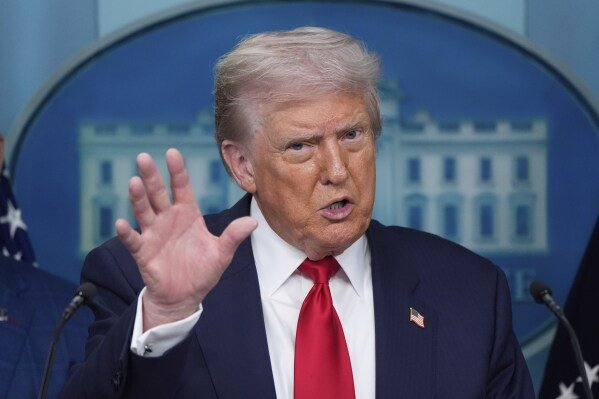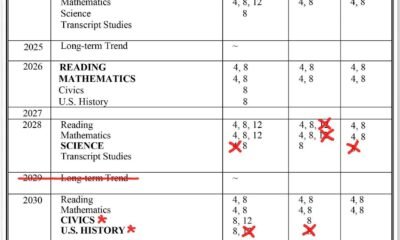Top Stories
US and China extend trade truce another 90 days, easing tension between world’s largest economies

WASHINGTON (AP) — President Donald Trump extended a trade truce with China for another 90 days Monday, at least delaying once again a dangerous showdown between the world’s two biggest economies.
Trump posted on his Truth Social platform that he signed the executive order for the extension, and that “all other elements of the Agreement will remain the same.” Beijing at the same time also announced the extension of the tariff pause, according to the Ministry of Commerce.
The previous deadline was set to expire at 12:01 a.m. Tuesday. Had that happened the U.S. could have ratcheted up taxes on Chinese imports from an already high 30%, and Beijing could have responded by raising retaliatory levies on U.S. exports to China.
The pause buys time for the two countries to work out some of their differences, perhaps clearing the way for a summit later this year between Trump and Chinese President Xi Jinping, and it has been welcomed by the U.S. companies doing business with China.
Sean Stein, president of the U.S.-China Business Council, said the extension is “critical” to give the two governments time to negotiate a trade agreement that U.S. businesses hope would improve their market access in China and provide the certainty needed for companies to make medium- and long-term plans.
“Securing an agreement on fentanyl that leads to a reduction in U.S. tariffs and a rollback of China’s retaliatory measures is acutely needed to restart U.S. agriculture and energy exports,” Stein said.
China said Tuesday it would extend relief to American companies who were placed on an export control list and an unreliable entities list. After Trump initially announced tariffs in April, China restricted exports of dual-use goods to some American companies, while banning others from trading or investing in China. The Ministry of Commerce said it would stop those restrictions for some companies, while giving others another 90-day extension.
Reaching a pact with China remains unfinished business for Trump, who has already upended the global trading system by slapping double-digit taxes – tariffs – on almost every country on earth.
The European Union, Japan and other trading partners agreed to lopsided trade deals with Trump, accepting once unthinkably U.S. high tariffs (15% on Japanese and EU imports, for instance) to ward off something worse.
Trump’s trade policies have turned the United States from one of the most open economies in the world into a protectionist fortress. The average U.S. tariff has gone from around 2.5% at the start of the year to 18.6%, highest since 1933, according to the Budget Lab at Yale University.
But China tested the limits of a U.S. trade policy built around using tariffs as a cudgel to beat concessions out of trading partners. Beijing had a cudgel of its own: cutting off or slowing access to its rare earths minerals and magnets – used in everything from electric vehicles to jet engines.
In June, the two countries reached an agreement to ease tensions. The United States said it would pull back export restrictions on computer chip technology and ethane, a feedstock in petrochemical production. And China agreed to make it easier for U.S. firms to get access to rare earths.
“The U.S. has realized it does not have the upper hand,’’ said Claire Reade, senior counsel at Arnold & Porter and former assistant U.S. trade representative for China affairs.
In May, the U.S. and China had averted an economic catastrophe by reducing massive tariffs they’d slapped on each other’s products, which had reached as high as 145% against China and 125% against the U.S.
Those triple-digit tariffs threatened to effectively end trade between the United States and China and caused a frightening sell-off in financial markets. In a May meeting in Geneva they agreed to back off and keep talking: America’s tariffs went back down to a still-high 30% and China’s to 10%.
Having demonstrated their ability to hurt each other, they’ve been talking ever since.
“By overestimating the ability of steep tariffs to induce economic concessions from China, the Trump administration has not only underscored the limits of unilateral U.S. leverage, but also given Beijing grounds for believing that it can indefinitely enjoy the upper hand in subsequent talks with Washington by threatening to curtail rare earth exports,’’ said Ali Wyne, a specialist in U.S.-China relations at the International Crisis Group. “The administration’s desire for a trade détente stems from the self-inflicted consequences of its earlier hubris.”
It’s unclear whether Washington and Beijing can reach a grand bargain over America’s biggest grievances. Among these are lax Chinese protection of intellectual property rights and Beijing’s subsidies and other industrial policies that, the Americans say, give Chinese firms an unfair advantage in world markets and have contributed to a massive U.S. trade deficit with China of $262 billion last year.
Reade doesn’t expect much beyond limited agreements such as the Chinese saying they will buy more American soybeans and promising to do more to stop the flow of chemicals used to make fentanyl and to allow the continued flow of rare-earth magnets.
But the tougher issues will likely linger, and “the trade war will continue grinding ahead for years into the future,’’ said Jeff Moon, a former U.S. diplomat and trade official who now runs the China Moon Strategies consultancy.
___
Associated Press Staff Writers Josh Boak and Huizhong Wu contributed to this story.
Top Stories
Russia says it will not discuss foreign troops in Ukraine in ‘any format’ | Politics News

Foreign Ministry spokeswoman says deployment of a post-conflict security force would be ‘fundamentally unacceptable’.
Published On 4 Sep 2025
Russia has flatly rejected the prospect of any talks that consider the deployment of foreign troops in Ukraine.
Ministry of Foreign Affairs spokeswoman Maria Zakharova said on Wednesday that Moscow would not entertain discussion of an international post-conflict security force “in any format”.
“Russia is not going to discuss the fundamentally unacceptable and security-undermining foreign intervention in Ukraine in any form, in any format,” Zakharova told reporters on the sidelines of the Eastern Economic Forum in Vladivostok.
Zakharova said that European leaders, who are working on plans for a multinational force in the event of an agreement to end the war in Ukraine, should take note that the “next time they aim to discuss this topic, they should have a pointer in the form of Russia’s position”.
“Judging by Ukraine’s losses, the European Commission has simply outdone itself,” she said.
Zakharova made her comments after European Commission President Ursula von der Leyen told The Financial Times earlier this week that the European Union had “pretty precise plans” for deploying a multinational force to Ukraine.
Ukrainian President Volodymyr Zelenskyy and European leaders are set to meet in Paris on Thursday to firm up details of post-conflict security guarantees for Kyiv.
On Wednesday, French President Emmanuel Macron said the details of the security guarantees for Ukraine had been worked out but remained “extremely confidential”.
“We are ready, we the Europeans, to offer the security guarantees to Ukraine and Ukrainians the day that a peace [accord] is signed,” Macron said.
Despite United States President Donald Trump’s pledge to bring a swift end to the conflict, Moscow and Kyiv remain far apart on the terms of any potential peace agreement.
Russia has said that any deal with Ukraine would need to include land in four regions it has annexed since 2022, while Kyiv has ruled out ceding any territory.
Trump is scheduled to speak with Zelenskyy by phone on Thursday, and has said he intends to speak to Putin in the coming days.
Top Stories
Louisiana prison chosen for immigration detainees due to its notoriety, says Noem | US immigration

The Trump administration purposefully chose a notorious Louisiana prison to hold immigration detainees as a way to encourage people in the US illegally to self-deport, Department of Homeland Security (DHS) secretary Kristi Noem said Wednesday.
A complex inside the Louisiana state penitentiary, an immense rural prison better known as Angola, will be used to detain those whom Noem described as the “worst of the worst” Immigration and Customs Enforcement (Ice) detainees. Noem was speaking to reporters as she stood on the grounds of the facility near a new sign reading, “Louisiana Lockup.”
“This facility will hold the most dangerous of criminals,” Noem said, adding it had “absolutely” been chosen for its reputation.
Officials said 51 detainees were already being housed at Angola. But Louisiana governor Jeff Landry said he expects the building to be filled to capacity, expecting over 400 people to come in ensuing months, as president Donald Trump continues his large-scale attempt to remove millions of people suspected of entering the country illegally.
The dirt road to the new Ice facility meanders past lofty oak trees, green fields and other buildings – including a white church and a structure with a sign that says, “Angola Shake Down Team”.
The facility is surrounded by a fence with five rows of stacked barbed wire. Overlooking the outdoor area is a tower, where a guard paced back and forth.
At the prison entrance a sign reads: “You are entering the land of new beginnings.”
The Associated Press joined officials for a brief tour of the facility, viewing some of the cells where detainees would be held. The cells, built of three cinder block walls and steel bars on the front, were single occupancy – one bed, toilet and sink in each.
Outside were confined enclosures of chain-link fencing, tall enough for multiple people to stand in.
“If you don’t think that they belong in somewhere like this,” Landry said of the detainees during Wednesday’s news conference, “you’ve got a problem.”
The building holding Ice detainees is not new, but rather refurbished after sitting vacant for years. The rest of Angola, which is made up of many buildings, has remained active. Many of Angola’s 6,300 inmates still work the fields, picking long rows of vegetables by hand as armed guards patrol on horseback.
In addition, the prison is home to more than 50 death row inmates. The most recent execution was in March, using nitrogen gas to deprive the inmate of oxygen, causing death. The state’s electric chair, nicknamed “Gruesome Gertie”, is still on display in the prison’s museum.
The notoriety of the 18,000-acre (7,300-hectare) prison stretches back well over a century. Described in the 1960s and 1970s as “the bloodiest prison in America,” it has seen violence, mass riots, escapes, brutality, inhumane conditions and executions.
The Trump administration has crafted its immigration messaging to reinforce a tough-on-crime image and create a sense of fear among people in the US illegally, most pointedly with the detention center dubbed Alligator Alcatraz that it built in the Florida Everglades.
The Everglades facility may soon be completely empty after a judge upheld her decision ordering operations there to wind down indefinitely.
Racing to expand the infrastructure necessary for increasing deportations, the federal government and state allies have announced a series of new immigration detention facilities, including the “Speedway Slammer” in Indiana and the “Cornhusker Clink” in Nebraska.
The approximate 400 people the Angola immigration facility will be able to hold is just a tiny percentage of the more than 100,000 people that Ice seeks to detain under a $45bn expansion for immigration detention centers that Trump signed into law in July.
The prison traces its history back to a series of wealthy slave traders and cotton planters who built an operation known as Angola Plantation. An 1850s news report said it had 700 slaves, who historians say were forced to work from dawn to dark in Louisiana’s brutal summer heat.
The plantation became the state prison after the Civil War, with a former Confederate officer awarded a lease that gave him control over the property and its convicts.
“The majority of black inmates were subleased to land owners to replace slaves while others continued levee, railroad, and road construction,” the museum’s website says. White inmates at the time worked as clerks or craftsmen.
Inmate leasing ended in the late 1800s amid a public outcry, and the state took direct control of the prison in 1901.
Top Stories
Here are the Powerball winning numbers for Wednesday, Sept. 3, 2025

DETROIT – The Powerball drawing on Wednesday night is worth more than $1.4 billion.
The cash option for the jackpot is $634.3 million.
If someone wins the jackpot, it would be the fourth-largest Powerball jackpot ever and the sixth-largest jackpot in U.S. lottery history.
Michigan last saw a Powerball jackpot winner on Jan. 1, 2024. A Mid-Michigan lottery club won an $842.4 million prize with a ticket purchased in Grand Blanc. That remains the largest Powerball prize ever won in Michigan.
Winning Powerball numbers for Sept. 3, 2025
Powerball numbers: 61-29-69-16-03
Powerball: 22
Powerplay multiplier: 2x
How do you play Powerball?
Powerball tickets cost $2 per play. In Idaho and Montana, the game is bundled with Power Play, making the minimum cost $3 per play. They can be purchased at stores across Michigan or online at MichiganLottery.com.
Players select five numbers between 1 and 69 for the white balls, then one number between 1 and 26 for the red Powerball. Numbers can be chosen manually on a play slip or randomly by the lottery terminal.
The jackpot is won by matching all five white balls in any order and the red Powerball.
Drawings take place every Monday, Wednesday, and Saturday at 10:59 p.m. Eastern time at the Florida Lottery draw studio in Tallahassee.
Jackpot winners can choose to receive their prize as an annuity, paid in 30 graduated payments over 29 years, or as a lump sum. Both prize options are before federal and jurisdictional taxes.
Copyright 2025 by WDIV ClickOnDetroit – All rights reserved.
-

 Business6 days ago
Business6 days agoThe Guardian view on Trump and the Fed: independence is no substitute for accountability | Editorial
-
Tools & Platforms3 weeks ago
Building Trust in Military AI Starts with Opening the Black Box – War on the Rocks
-

 Ethics & Policy1 month ago
Ethics & Policy1 month agoSDAIA Supports Saudi Arabia’s Leadership in Shaping Global AI Ethics, Policy, and Research – وكالة الأنباء السعودية
-

 Events & Conferences4 months ago
Events & Conferences4 months agoJourney to 1000 models: Scaling Instagram’s recommendation system
-

 Jobs & Careers2 months ago
Jobs & Careers2 months agoMumbai-based Perplexity Alternative Has 60k+ Users Without Funding
-

 Education2 months ago
Education2 months agoVEX Robotics launches AI-powered classroom robotics system
-

 Funding & Business2 months ago
Funding & Business2 months agoKayak and Expedia race to build AI travel agents that turn social posts into itineraries
-

 Podcasts & Talks2 months ago
Podcasts & Talks2 months agoHappy 4th of July! 🎆 Made with Veo 3 in Gemini
-

 Podcasts & Talks2 months ago
Podcasts & Talks2 months agoOpenAI 🤝 @teamganassi
-

 Education2 months ago
Education2 months agoAERDF highlights the latest PreK-12 discoveries and inventions





















